Communist Party of India (Marxist)
Communist Party of India (Marxist) | |
|---|---|
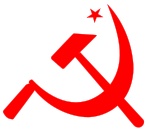 | |
| Abbreviation | CPI(M) |
| General Secretary | Sitaram Yechury |
| Lok Sabha leader | P.R. Natarajan |
| Rajya Sabha leader | Elamaram Kareem |
| Founder |
|
| Founded | 7 November 1964 |
| Split from | Communist Party of India |
| Headquarters | A. K. Gopalan Bhawan, 27-29, Bhai Vir Singh Marg, New Delhi-110 001 |
| Newspaper | People's Democracy Ganashakti Deshabhimani Theekkathir |
| Student wing | Students' Federation of India |
| Youth wing | Democratic Youth Federation of India |
| Women's wing | All India Democratic Women's Association |
| Labour wing | Centre of Indian Trade Unions |
| Peasant's wing | All India Kisan Sabha |
| Ideology | Communism Marxism[3] |
| Political position | Left-wing[4] |
| International affiliation | IMCWP |
| Colours | Red |
| ECI Status | National Party[5] |
| Alliance | show List |
| Seats in Lok Sabha | 3 / 543 |
| Seats in Rajya Sabha | 6 / 245 |
| Seats in State Legislative Assemblies | 88 / 4,036 show Indian states |
| Number of states and union territories in government | 2 / 31 |
| Election symbol | |
 | |
| Party flag | |
 | |
| Website | |
| cpim | |
| |
The Communist Party of India (Marxist) (abbr. CPI(M)) is a communist political party in India.[3] It is one of the national parties of India.[5] The party emerged from a split from the Communist Party of India in 1964. The CPI(M) was formed in Calcutta from 31 October to 7 November 1964.
As of 2021, CPI(M) is leading the state government in Kerala and has representation in the following Legislative assemblies in the states of Tripura, Assam, Rajasthan, Bihar, Himachal Pradesh, Odisha, Tamil Nadu and Maharashtra.[6] The Politburo is the supreme authority of the Communist Party of India (Marxist).[7] However, in between two party congresses, the Central Committee is the highest decision making body.[7]
| Part of a series on |
| Communist parties |
|---|
|
History[]
Name[]
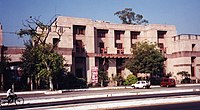
CPI(M) is officially known as भारत की कम्युनिस्ट पार्टी मार्क्सवादी (Bharat ki Kamyunist Party Marksvadi) in Hindi, but it is often known as मार्क्सवादी कम्युनिस्ट पार्टी (Marksvadi Kamyunist Party, abbreviated MaKaPa) in press and media circles. During its initial years after the split, the party was often referred to by different names such as 'Left Communist Party' or 'Communist Party of India (Left)'. The party has used the name 'Left' because CPI people were dubbed as a rightist in nature for their support of the Congress-Nehru regime. During the Kerala Legislative Assembly elections of 1965, the party adopted the name 'Communist Party of India (Marxist)' and applied to obtain its election symbol from the Election Commission of India.[8]
As Communist Party of India (1925-1964)[]



The Communist Party of India (Marxist) emerged from a division within the Communist Party of India (CPI), which was formed on 26 December 1925.[9] The CPI had experienced a period of upsurge during the years following the Second World War. The CPI led armed rebellions in Telangana, Tripura, and Kerala. However, it soon abandoned the strategy of armed revolution in favor of working within the parliamentary framework. In 1950, B. T. Ranadive, the CPI general secretary and a prominent representative of the radical sector inside the party, was demoted on grounds of left-adventurism.[citation needed]

Under the government of the Indian National Congress party of Jawaharlal Nehru, independent India developed close relations and a strategic partnership with the Soviet Union. The Soviet government consequently wished that the Indian communists moderate their criticism towards the Indian state and assume a supportive role towards the Congress governments. However, large sections of the CPI claimed that India remained a semi-feudal country and that class struggle could not be put on the back-burner for the sake of guarding the interests of Soviet trade and foreign policy.[citation needed] Moreover, the Indian National Congress appeared to be generally hostile towards political competition. In 1959 the central government intervened to impose President's Rule in Kerala, toppling the E.M.S. Namboodiripad cabinet (the sole non-Congress state government in the country).[10]
Formation of CPI(M) (1964)[]
The basis of difference in opinion between the two factions in CPI was ideological – about the assessment of the Indian scenario and the development of a party program. This difference in opinion was also a reflection of a similar difference at international level on ideology between the Soviet and Chinese parties. The alleged 'right-wing' inside the party followed the Soviet path[11] whereas the 'left-wing' wanted to follow the Chinese principle of a mass party with a class line with national characteristics. Moreover, the faction of CPI which later became CPI(M) referred to the "right" strategy as a national approach of class collaboration, a damning charge within the communist movement where the prioritization of working-class interests and independence is considered paramount.[11][12] It was this ideological difference which later intensified, coupled with the Soviet-Chinese split at the international level and ultimately gave birth to CPI(M).[13]
Hundreds of CPI leaders, accused of being pro-Chinese, were imprisoned. Thousands of Communists were detained without trial.[14][11]
In 1962 Ajoy Ghosh, the general secretary of the CPI died. After his death, S.A. Dange was installed as the party chairman (a new position) and E.M.S. Namboodiripad as general secretary. This was an attempt to achieve a compromise.
At a CPI National Council meeting held on 11 April 1964, 32 Council members walked out.[15]
The leftist section, to which the 32 National Council members belonged, organized a convention in Tenali, Andhra Pradesh 7 to 11 July. In this convention, the issues of the internal disputes in the party were discussed. 146 delegates, claiming to represent 100,000 CPI members, took part in the proceedings. The convention decided to convene the 7th Party Congress of CPI in Calcutta later the same year.[16]
Marking a difference from the official sector of CPI, the Tenali convention was marked by the display of a large portrait of the Chinese Communist leader Mao Zedong.[16]
At the Tenali convention a Bengal-based pro-Chinese group, representing one of the most radical streams of the CPI left-wing, presented a draft program proposal of their own. These radicals criticized the draft program proposal prepared by M. Basavapunniah for undermining class struggle and failing to take a clear pro-Chinese position in the ideological conflict between the Communist Party of the Soviet Union (CPSU) and the Chinese Communist Party (CCP).[17]
After the Tenali convention, the CPI left-wing organized party district and state conferences. In West Bengal, a few of these meetings became battlegrounds between the most radical elements and the more moderate leadership. At the Calcutta Party District Conference, an alternative draft program was presented to the leadership by Parimal Das Gupta (a leading figure amongst far-left intellectuals in the party). Another alternative proposal was brought forward to the Calcutta Party District Conference by Aziz ul Haq, but Haq was initially banned from presenting it by the conference organizers. At the Calcutta Party District Conference, 42 delegates opposed M. Basavapunniah's official draft program proposal.[18]
At the Siliguri Party District Conference, the main draft proposal for a party program was accepted, but with some additional points suggested by the far-left North Bengal cadre Charu Majumdar. However, Harekrishna Konar (representing the leadership of the CPI left-wing) forbade the raising of the slogan Mao Tse-Tung Zindabad (Long live Mao Tse-Tung) at the conference.[18]
Parimal Das Gupta's document was also presented to the leadership at the West Bengal State Conference of the CPI leftwing. Das Gupta and a few others spoke at the conference, demanding the party ought to adopt the class analysis of the Indian state of the 1951 CPI conference. His proposal was, however, voted down.[18]
The Calcutta Congress was held between 31 October and 7 November, at Tyagraja Hall in southern Calcutta. Simultaneously, the CPI convened a Party Congress in Bombay.[citation needed] The group which assembled in Calcutta would later adopt the name 'Communist Party of India (Marxist)', to differentiate themselves from the CPI. The CPI(M) also adopted its own political program. P. Sundarayya was elected general secretary of the party.[11][12]
In total 422 delegates took part in the Calcutta Congress. CPI(M) claimed that they represented 104,421 CPI members, 60% of the total party membership.[19]
At the Calcutta conference, the party adopted a class analysis of the character of the Indian state, that claimed the Indian bourgeoisie was increasingly collaborating with imperialism.[20]
Parimal Das Gupta's alternative draft program was not circulated at the Calcutta conference. However, Souren Basu, a delegate from the far-left stronghold Darjeeling, spoke at the conference asking why no portrait had been raised of Mao Tse-Tung along with the portraits of other communist stalwarts. His intervention was met with huge applause from conference delegates.[20]
Early years of CPI(M) (1964-1966)[]
The CPI (M) was born into a hostile political climate. At the time of the holding of its Calcutta Congress, large sections of its leaders and cadres were jailed without trial. Again on 29–30 December, over a thousand CPI (M) cadres were arrested and detained and held in jail without trial.[21] In 1965 new waves of arrests of CPI(M) cadres took place in West Bengal, as the party launched agitations against the rise in fares in the Calcutta Tramways and against the then-prevailing food crisis. Statewide general strikes and hartals were observed on 5 August 1965, 10–11 March 1966, and 6 April 1966.[21] The March 1966 general strike resulted in several deaths during confrontations with police forces.[21]
Also in Kerala, mass arrests of CPI(M) cadres were carried out during 1965. In Bihar, the party called for a Bandh (general strike) in Patna on 9 August 1965 in protest against the Congress state government.[21] During the strike, police resorted to violent actions against the organizers of the strike. The strike was followed by agitations in other parts of the state.[21]
P. Sundaraiah, after being released from jail, spent the period of September 1965 – February 1966 in Moscow for medical treatment. In Moscow, he also held talks with the CPSU.[21]
The Central Committee of CPI(M) held its first meeting on 12–19 June 1966. The reason for delaying the holding of a regular CC meeting was the fact that several of the persons elected as CC members at the Calcutta Congress were jailed at the time.[22] A CC meeting had been scheduled to have been held in Trichur during the last days of 1964, but had been canceled due to the wave of arrests against the party. The meeting discussed tactics for electoral alliances and concluded that the party should seek to form a broad electoral alliance with all non-reactionary opposition parties in West Bengal (i.e. all parties except Jan Sangh and Swatantra Party). This decision was strongly criticized by the Communist Party of China, the Party of Labour of Albania, the Communist Party of New Zealand, and the radicals within the party itself. The line was changed at a National Council meeting in Jullunder in October 1966, where it was decided that the party should only form alliances with select left parties.[23]
Naxalbari uprising (1967)[]
At this point, the party stood at crossroads. There were radical sections of the party who were wary of the increasing parliamentary focus of the party leadership, especially after the electoral victories in West Bengal and Kerala. Developments in China also affected the situation inside the party. In West Bengal, two separate internal dissident tendencies emerged, which both could be identified as supporting the Chinese line.[24]
In 1967 a peasant uprising broke out in Naxalbari, in northern West Bengal. The insurgency was led by hardline district-level CPI(M) leaders Charu Majumdar and Kanu Sanyal. The hardliners within CPI(M) saw the Naxalbari uprising as the spark that would ignite the Indian revolution. The Communist Party of China hailed the Naxalbari movement, causing an abrupt break in CPI(M)-CPC relations.[25]
The Naxalbari movement was violently repressed by the West Bengal government, of which CPI(M) was a major partner. Within the party, the hardliners rallied around an All India Coordination Committee of Communist Revolutionaries.[citation needed] Following the 1968 Burdwan plenum of CPI(M) (held on 5–12 April 1968), the AICCCR separated themselves from CPI(M).[citation needed] This split divided the party throughout the country. But notably in West Bengal, which was the center of the violent radicalized stream, no prominent leading figure left the party. The party and the Naxalites (as the rebels were called) were soon to get into a bloody feud.[citation needed]
In Andhra Pradesh, another revolt was taking place. There the pro-Naxalbari dissidents had not established any presence. But in the party organization, there were many veterans from the Telangana armed struggle, who rallied against the central party leadership. In Andhra Pradesh, the radicals had a strong base even amongst the state-level leadership. The main leader of the radical tendency was T. Nagi Reddy, a member of the state legislative assembly. On 15 June 1968, the leaders of the radical tendency published a press statement outlining the critique of the development of CPI(M). It was signed by T. Nagi Reddy, D.V. Rao, Kolla Venkaiah, and Chandra Pulla Reddy.[26]
In total around 50% of the party cadres in Andhra Pradesh left the party to form the Andhra Pradesh Coordination Committee of Communist Revolutionaries, under the leadership of T. Nagi Reddy.[27]
Dismissal of United Front governments in West Bengal and Kerala (1967-1970)[]
In November 1967, the West Bengal United Front government was dismissed by the central government. Initially, the Indian National Congress formed a minority government led by Prafulla Chandra Ghosh, but that cabinet did not last long. Following the proclamation that the United Front government had been dislodged, a 48-hour hartal was effective throughout the state.[citation needed] After the fall of the Ghosh cabinet, the state was put under President's Rule. CPI(M) launched agitations against the interventions of the central government in West Bengal.[citation needed]
The 8th Party Congress of CPI(M) was held in Cochin, Kerala, on 23–29 December 1968. On 25 December 1968, whilst the congress was held, 42 Dalits were burned alive in the Tamil village of Kizhavenmani. The massacre was a retaliation from landlords after Dalit labourers had taken part in a CPI(M)-led agitation for higher wages.[28][29]
The United Front government in Kerala was forced out of office in October 1969, as the CPI, RSP, KTP, and Muslim League ministers resigned. E.M.S. Namboodiripad handed in his resignation on 24 October.[30] A coalition government led by CPI leader C. Achutha Menon was formed, with the outside support of the Indian National Congress.
Elections in West Bengal and Kerala[]
Fresh elections were held in West Bengal in 1969. CPI(M) contested 97 seats and won 80. The party was now the largest in the West Bengal legislative.[31] But with the active support of CPI and the Bangla Congress, Ajoy Mukherjee was returned as Chief Minister of the state. Mukherjee resigned on 16 March 1970, after a pact had been reached between CPI, Bangla Congress, and the Indian National Congress against CPI(M). CPI(M) strove to form a new government, instead but the central government put the state under President's Rule.
In Kerala, fresh elections were held in 1970. CPI(M) contested 73 seats and won 29. After the election, Achutha Menon formed a new ministry, including ministers from the Indian National Congress.[citation needed]
Formation of CITU (1970)[]
Centre of Indian Trade Unions, CITU is a National level Trade Union in India and its trade union wing is a spearhead of the Indian Trade Union Movement.[citation needed] The Centre of Indian Trade Unions is today one of biggest assembly of workers and classes of India. It has strong unchallangeable presence in the Indian state of Tripura besides a good presence in West Bengal, Kerala and Kanpur. They have an average presence in Tamil Nadu and Andhra Pradesh.

According to the provisional statistics from the Ministry of Labour, CITU had a membership of approximately 6,040,000 in 2015.[32]
Tapan Kumar Sen is the General Secretary and K. Hemalata is the president of CITU. K. Hemalata was the first woman President in CITU who was elected after A. K. Padmanabhan.[33] It runs a monthly organ named WORKING CLASS.
CITU is affiliated to the World Federation of Trade Unions.[34]
Outbreak of war in East Pakistan (1971-1972)[]
In 1971 Bangladesh (formerly East Pakistan) declared its independence from Pakistan. The Pakistani military tried to quell the uprising. India intervened militarily and gave active backing to the Bangladeshi rebels.[citation needed] Millions of Bangladeshi refugees sought shelter in India, especially in West Bengal.[citation needed]
At the time the radical sections of the Bangladeshi communist movement were divided into many factions. Whilst the pro-Soviet Communist Party of Bangladesh actively participated in the rebellion, the pro-China communist tendency found itself in a peculiar situation as China had sided with Pakistan in the war. In Calcutta, where many Bangladeshi leftists had sought refuge, CPI(M) worked to co-ordinate the efforts to create a new political organization. In the fall of 1971 three small groups, which were all hosted by the CPI(M), came together to form the Bangladesh Communist Party (Leninist). The new party became the sister party of CPI(M) in Bangladesh.[35]
Boycott of Assembly & Emergency rule (1972–1977)[]
In 1975, the Prime Minister of India, Indira Gandhi imposed a national emergency on the premise of internal disturbances suspending elections, legitimising rule by decree and curbing civil liberties.[36] The proposition for the declaration of the emergency and the formal draft of the ordinance were both notably corroborated to have been forwarded by Siddhartha Shankar Ray.[37][38][39] The Communist Party of India (Marxist) emerged as one of the primary opposition to the emergency rule of Indira Gandhi.[36] The following period witnessed a succession of authoritarian measures and political repression, which was particularly severe in West Bengal.[40] The members of the CPI-M's labour union became the first subject to political repression and mass arrests while the rest of the members of the CPI-M went underground.[41]
With the initiation of the Jayaprakash Narayan (JP)'s movement, the CPI-M began providing support to it and went on to participate in discussions for the creation of a united front under the umbrella of the Janata Party. Several of the leaders of the CPI-M were also influenced by JP with Jyoti Basu noted to be one of his prominent admirers having worked under him in the All India Railwaymen's Federation during the 1940s.[41] The involvement of the Hindutva movement however complicated matters, according to JP the formal inclusion of the marxists who had underwent a splintering and whose organisation was localised in particular region would have been detrimental to the movement as the Rashtriya Swayamsevak Sangh members would switch sides if they joined.[41][42] JP and Basu eventually came to an agreement that the CPI-M would not formally join the Janata Party as it would weaken the movement.[41] After the revocation of the emergency, the CPI-M joined an electoral alliance with the Janata Party in the 1977 Indian general election which resulted in an overwhelming victory for the Janata Alliance.[43]
Left Front Government formation in West Bengal, Kerala and Tripura assembly (1977 afterwards)[]
West Bengal[]



For the 1977 West Bengal Legislative Assembly election, negotiations between the Janata Party and the Communist Party of India (Marxist) broke down.[44] This led to a three sided contested between the Indian National Congress, the Janata Party and the Communist Party of India (Marxist) led Left Front coalition. The results of the election was a surprising sweep for the Left Front winning 230 seats out of 290 with the CPI-M winning an absolute majority on its own, Basu became the Chief Minister of West Bengal for the next 23 years until his retirement in 2000. Basu was also repeatedly elected as the representative of the Satgachhia constituency from 1977 to 2001.[45]
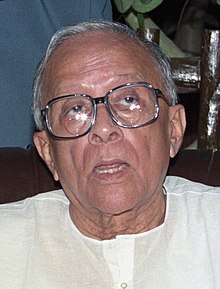
From 2000 to 2010 CPI(M) led by Buddhadeb Bhattacharjee was the Chief Minister of West Bengal for 10 years.
Kerala[]

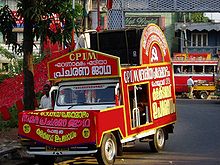
In the late 1970s and early 1980s, two main pre-poll political alliances were formed: the Left Democratic Front (LDF), led by the Communist Party of India (Marxist) and Communist Party of India and the United Democratic Front (UDF), led by the Indian National Congress. These pre-poll political alliances of Kerala have stabilized strongly in such a manner that, with rare exceptions, most of the coalition partners stick their loyalty to the respective alliances (Left Democratic Front or United Democratic Front).
LDF first came into power in Kerala Legislative Assembly in 1980 under the leadership of E. K. Nayanar who later became the longest serving Chief Minister of Kerala, ever since 1980 election, the power has been clearly alternating between the two alliances till the 2016. In 2016, LDF won the 2016 election and had a historic re-election in 2021 election where an incumbent government was re-elected for first time in 40 years. Pinarayi Vijayan is the first Chief minister of Kerala to be re-elected after completing a full term (five years) in office.[46]
Tripura[]

The Left Front governed Tripura 1978–1988, and again from 1993 to 2018.[47] The Communist Party of India (Marxist) is the dominant party in the coalition.[47][48] The other three members of the Left Front are the Communist Party of India, the Revolutionary Socialist Party and the All India Forward Bloc.[49]
Leadership and organisation[]
CPI(M) currently has three MPs in Lok Sabha. CPI(M)'s highest tally was in 2004 when it got 5.66% of votes polled in and it had 43 MPs. It won 42.31% on an average in the 69 seats it contested. It supported the new Indian National Congress-led United Progressive Alliance government, but without becoming a part of it. On 9 July 2008 it formally withdrew support from the UPA government explaining this by differences about the Indo-US nuclear deal and the IAEA Safeguards Agreement in particular.[50]
In West Bengal and Tripura it participates in the Left Front. In Kerala the party is part of the Left Democratic Front. In Tamil Nadu, it is part of the Secular Progressive Alliance led by the Dravida Munnetra Kazhagam (DMK).
Its members in Great Britain are in the electoral front Unity for Peace and Socialism with the Communist Party of Britain and the British domiciled sections of the Communist Party of Bangladesh and the Communist Party of Greece (KKE). It is standing 13 candidates in the London-wide list section of the London Assembly elections in May 2008.[51]


Leadership[]
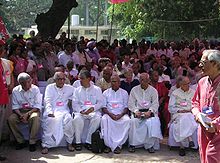

The current general secretary of CPI(M) is Sitaram Yechury. The 22nd party congress of CPI(M), held in Hyderabad 18 April 2018 elected a Central Committee with 95 members including 2 permanent invitees, 6 invitees and a five-member Central Control Commission. The Central Committee later elected a 17-member Politburo:[52]
Politburo members[]
| No. | Name | State |
|---|---|---|
| 1 | Sitaram Yechury (General Secretary) | Andhra Pradesh |
| 2 | Prakash Karat (Former General Secretary) | West Bengal |
| 3 | S. Ramachandran Pillai | Kerala |
| 4 | Manik Sarkar (Former Chief Minister of Tripura) | Tripura |
| 5 | Pinarayi Vijayan (Chief Minister of Kerala) | Kerala |
| 6 | Biman Bose | West Bengal |
| 7 | B. V. Raghavulu | Andhra Pradesh |
| 8 | Brinda Karat | West Bengal |
| 9 | Kodiyeri Balakrishnan | Kerala |
| 10 | Surja Kanta Mishra | West Bengal |
| 11 | M. A. Baby | Kerala |
| 12 | Mohammed Salim | West Bengal |
| 13 | Subhashini Ali | Uttar Pradesh |
| 14 | Hannan Mollah | West Bengal |
| 15 | G.Ramakrishnan | Tamil Nadu |
| 16 | Tapan Kumar Sen | West Bengal |
| 17 | Nilotpal Basu | West Bengal |
The 22nd party congress newly inducts Tapan Sen and Nilotpal Basu into the Politburo.[52][53][54]
General Secretaries of CPI(M)[]
Article XV, Section 15 of the party constitution says:
"No person can hold the position of the General Secretary for more than three full terms. Full term means the period between two Party Congresses. In a special situation, a person who has completed three full terms as General Secretary may be re-elected for a fourth term provided it is so decided by the Central Committee with a three-fourth majority. But in no case can that person be elected again for another term in addition to the fourth term."[55]
| No | Photo | Name | Tenure |
|---|---|---|---|
| 1st |  |
P. Sundarayya | 1964–1978 |
| 2nd |  |
E.M.S. Namboodiripad | 1978–1992 |
| 3rd |  |
Harkishan Singh Surjeet | 1992–2005 |
| 4th |  |
Prakash Karat | 2005–2015 |
| 5th |  |
Sitaram Yechury | 2015–Present |
Principal mass organisations of CPI(M)[]
- Democratic Youth Federation of India
- Students Federation of India
- Centre of Indian Trade Unions class organization
- All India Kisan Sabha peasants' organization
- All India Agricultural Workers Union
- Kerala Non-Gazetted Officers Union
- All India Democratic Women's Association
- Bank Employees Federation of India
- Ganamukti Parishad
In Tripura, the Ganamukti Parishad is a major mass organisation amongst the Tripuri peoples of the state. In Kerala, the Adivasi Kshema Samithi, a tribal organization, is controlled by CPI(M).
Presence in states[]
As of 2021 Kerala Legislative Assembly Election , the CPI(M) heads the state government in Kerala. Pinarayi Vijayan is Chief Minister of Kerala. In Tamil Nadu it is in power with SPA coalition led by M. K. Stalin. The Left Front under CPI(M) governed West Bengal for 34 years (1977–2011) and Tripura for 25 years (1993–2018).

State Governments[]
| S.No | State/ | Govt Since | Chief Minister | Alliance | Coalition Seats in Assembly | Last election | |||||
|---|---|---|---|---|---|---|---|---|---|---|---|
| Portrait | Name | Party | Seats | Since | |||||||
| 1 | Kerala | 26 May 2016 | 
|
Pinarayi Vijayan | CPI(M) | 62 | 26 May 2016 | Left Democratic Front (Kerala) | 99 / 140
|
6 April 2021 | |
| 2 | Tamil Nadu | 7 May 2021 | 
|
M. K. Stalin | DMK | 133 | 7 May 2021 | Secular Progressive Alliance | 159 / 234
|
6 April 2021 | |
Seats in State Legislative Assemblies[]
Indian general elections results[]

| Year | Legislature | Total Lok Sabha constituencies | Seats won / Seats Contested | Change in seats | Total Votes | Percentage of votes | Change in vote % | Reference |
|---|---|---|---|---|---|---|---|---|
| 1967 | 4th Lok Sabha | 520 | 19 / 59
|
New | 6,246,522 | 4.28 % | New | [58] |
| 1971 | 5th Lok Sabha | 518 | 25 / 85
|
7,510,089 | 5.12 % | [59] | ||
| 1977 | 6th Lok Sabha | 542 | 22 / 53
|
8,113,659 | 4.29 % | [60] | ||
| 1980 | 7th Lok Sabha | 529(542*) | 37 / 64
|
12,352,331 | 6.24 % | [61] | ||
| 1984 | 8th Lok Sabha | 541 | 22 / 64
|
14,272,526 | 5.72 % | [62][63] | ||
| 1989 | 9th Lok Sabha | 529 | 33 / 64
|
19,691,309 | 6.55 % | [64] | ||
| 1991 | 10th Lok Sabha | 534 | 35 / 63
|
17,074,699 | 6.14 % | [65][66] | ||
| 1996 | 11th Lok Sabha | 543 | 32 / 75
|
20,496,810 | 6.12 % | [67] | ||
| 1998 | 12th Lok Sabha | 543 | 32 / 71
|
18,991,867 | 5.16 % | [68] | ||
| 1999 | 13th Lok Sabha | 543 | 33 / 72
|
19,695,767 | 5.40 % | [69] | ||
| 2004 | 14th Lok Sabha | 543 | 43 / 69
|
22,070,614 | 5.66 % | [70] | ||
| 2009 | 15th Lok Sabha | 543 | 16 / 82
|
22,219,111 | 5.33 % | [71] | ||
| 2014 | 16th Lok Sabha | 543 | 9 / 93
|
17,986,773 | 3.24 % | [72] | ||
| 2019 | 17th Lok Sabha | 543 | 3 / 71
|
10,744,908 | 1.75 % | [73] |
1967 general election[]
In the 1967 Lok Sabha elections, the CPI(M) nominated 59 candidates. In total 19 of them were elected. The party received 6.2 million votes (4.28% of the nationwide vote). By comparison, CPI won 23 seats and got 5.11% of the nationwide vote. In the state legislative elections held simultaneously, the CPI(M) emerged as a major party in Kerala and West Bengal. In Kerala, a United Front government led by E.M.S. Namboodiripad was formed.[74] In West Bengal, the CPI(M) was the main force behind the United Front government formed. The Chief Ministership was given to Ajoy Mukherjee of the Bangla Congress (a regional splinter group of the Indian National Congress).
1971 general election[]
With the backdrop of the Bangladesh War and the emerging role of Indira Gandhi as a populist national leader, the 1971 election to the Lok Sabha was held. The CPI(M) contested 85 seats and won in 25. In total the party mustered 7510089 votes (5.12% of the national vote). 20 of the seats came from West Bengal (including Somnath Chatterjee, elected from Burdwan), 2 from Kerala (including A.K. Gopalan, elected from Palakkad), 2 from Tripura (Biren Dutta and Dasarath Deb) and 1 from Andhra Pradesh.[75]
In the same year, state legislative elections were held in three states; West Bengal, Tamil Nadu, and Odisha. In West Bengal CPI(M) had 241 candidates, winning 113 seats. In total the party mustered 4241557 votes (32.86% of the statewide vote). In Tamil Nadu CPI(M) contested 37 seats, but drew blank. The party got 259298 votes (1.65% of the statewide vote). In Odisha, the party contested 11 seats and won in two. The CPI(M) vote in the state was 52785 (1.2% of the statewide vote).[76]
1977 general elections[]
In the 1977 Lok Sabha elections, the CPI(M) had fielded its candidates on 53 seats scattered around in 14 states and union territories of India. It won 4.29% of the average votes polled in this election. The party had won 17 seats from West Bengal, 3 from Maharashtra, and one each from Odisha and Punjab. This election was done shortly after the Emergency imposed by Indira Gandhi and reflected a wide uproar of masses against her draconian rule. A coalition of Opposition parties was formed against the Congress regime, CPI(M) too supported this coalition by not fielding its candidates against the Janta Party.[77]
1980 general elections[]
Janta Party coalition did not last much and two years after its formation India had faced the 1980s Lok Sabha Elections. This election saw an increase in the vote percentage of CPI(M) and the party secured more seats than the previous elections. The Party had contested elections in the 15 states and union territories of India and fielded its candidates on 64 seats. The party had won 37 seats in total. It won 28 seats in West Bengal, 7 in Kerala, and 2 seats in Tripura. The party emerged out as the whole sole representative of the people of Tripura in this election.[78]
2002 presidential elections[]
In the 2002 Presidential elections, Left Front announced Captain Lakshmi Sehgal as its presidential candidate. Against her was the ruling Bharatiya Janata Party's candidate A. P. J. Abdul Kalam.[79] CPI(M)'s Leadership has announced that in form of Captain Lakshmi, they are fielding an 'Alternative Candidate'. They said that though it is clear that Captain Lakshmi can't be the President of India because of the opposition of BJP led NDA and Indian National Congress to her, but through this Presidential Election Left wants to raise key national issues, and make them heard to the masses.[80] Captain Lakshmi herself had pointed out that this Presidential election reflects the opposition of the Indian Left to the Communal-Secreterian Politics of BJP and solidarity with the religious minorities who have suffered greatly under the National Democratic Alliance's leadership.[81]
2012 Vice-presidential election[]
While CPI(M) supported Pranab Mukherjee as presidential candidate in 2012 presidential election, it was in favour of a non-Congress candidate for the post of the Vice-President.[82]
2014 Lok Sabha election[]
Nine CPI(M) candidates were elected in the 2014 Indian general election, as well as two CPI(M)-supported independents. This is down from the previous number of 16. The national vote share of CPI(M) has also shrunk from 5.33% in 2009 to 3.28% in 2014. This is a 38.5% reduction within a span of 5 years which is consistent with the overall decline of the left in India.[83][84][failed verification] CPI(M) did not win a single seat in Tamil Nadu and its seats went down from 9 to 2 in West Bengal where it is being heavily eroded by Mamata Banerjee governed AITC. Kerala is the only state where CPI(M) gained one more seat but this is mainly attributed to the splitting of anti-LDF votes between the UDF and emerging NDA. The NDA saw a sharp spike in vote share in decades which came coupled with a sharp decline in UDF votes.[citation needed] Thus, it is assumed that the NDA cut into UDF votes thereby facilitating victory for LDF. This was again mirrored during the 2016 Kerala Legislative Assembly election, which saw the NDA getting entry into the State Assembly for the first time as BJP veteran O. Rajagopal wins the Nemom seat and CPI(M)'s Pinarayi Vijayan forming the LDF-ruled government.[citation needed]
2019 general election[]
The CPI(M) contested 65 seats nationwide and won three in the 2019 general election. One seat was won in Kerala, where the CPI(M) is leading the state government. Two other seats were won in Tamil Nadu, where the CPI(M) contested within the DMK-led coalition.[85]
State Legislative assembly results[]
| Year | State | Total assembly seats | Seats Won / Seats Contested | Change in Seats | Votes | Vote% | Change in vote% |
|---|---|---|---|---|---|---|---|
| 2021 | Assam | 126 | 1 / 2
|
160,758 | 0.84 % | ||
| Kerala | 140 | 62 / 77
|
5,288,502 | 25.38 % | |||
| Tamil Nadu | 234 | 2 / 6
|
390,455 | 0.84 % | N/A | ||
| West Bengal | 294 | 0 / 136
|
2,837,276 | 4.73 % | |||
| 2020 | Bihar | 243 | 2 / 4
|
274,155 | 0.65 % | ||
| 2019 | Andhra Pradesh | 175 | 0 / 2
|
101,071 | 0.32 % | N/A | |
| Maharashtra | 288 | 1 / 8
|
204,933 | 0.37 % | |||
| Odisha | 147 | 1 / 5
|
70,119 | 0.32 % | N/A | ||
| 2018 | Rajasthan | 200 | 2 / 28
|
434,210 | 1.2 % | ||
| Telangana | 119 | 0 / 26
|
91,099 | 0.40 % | N/A | ||
| Tripura | 60 | 16 / 57
|
9,93,605 | 42.22 % | |||
| 2017 | Himachal Pradesh | 68 | 1 / 14
|
55,558 | 1.5 % | ||
| Uttar Pradesh | 403 | 0 / 26
|
N/A | 35,207 | 0.04 % | N/A |
- Bold indicates if Largest Party/Vote share
- N/A indicates Not Available
- indicates in government or in Coalition government
List of Chief Ministers from CPI(M)[]
| Denotes the person is the incumbent chief minister |
| No | Name | Portrait | Term of office | Days in office | |
|---|---|---|---|---|---|
| Kerala | |||||
| 1 | E. M. S. Namboodiripad | 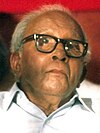
|
6 March 1967 | 1 November 1969 | 2 years 240 days |
| 2 | E. K. Nayanar | 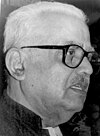
|
25 January 1980 | 20 October 1981 | 10 years 353 days |
| 26 March 1987 | 23 June 1991 | ||||
| 20 May 1996 | 16 May 2001 | ||||
| 3 | V. S. Achuthanandan | 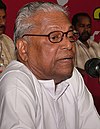
|
18 May 2006 | 17 May 2011 | 4 years 364 days |
| 4 | Pinarayi Vijayan | 
|
25 May 2016 | 20 May 2021 | 5 years, 100 days |
| 20 May 2021 | Incumbent | ||||
| Tripura | |||||
| 1 | Nripen Chakraborty | 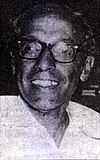
|
5 January 1978 | 4 February 1983 | 10 years 31 days |
| 5 February 1983 | 5 February 1988 | ||||
| 2 | Dasarath Deb | 
|
10 April 1993 | 11 March 1998 | 4 years, 335 days |
| 3 | Manik Sarkar | 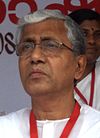
|
11 March 1998 | 26 February 2003 | 20 years |
| 27 February 2003 | 23 February 2008 | ||||
| 24 February 2008 | 14 February 2013 | ||||
| 15 February 2013 | 8 March 2018 | ||||
| West Bengal | |||||
| 1 | Jyoti Basu | 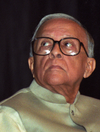
|
21 June 1977 | 23 May 1982 | 23 years 127 days |
| 24 May 1982 | 29 March 1987 | ||||
| 30 March 1987 | 18 June 1991 | ||||
| 19 June 1991 | 15 May 1996 | ||||
| 16 May 1996 | 5 November 2000 | ||||
| 2 | Buddhadeb Bhattacharya | 
|
6 November 2000 | 14 May 2001 | 10 years 188 days |
| 15 May 2001 | 17 May 2006 | ||||
| 18 May 2006 | 13 May 2011 | ||||
List of Rajya Sabha (Upper House) members[]
| No | Name | State | Date of Appointment | Date of Retirement |
|---|---|---|---|---|
| 1 | John Brittas | Kerala | 04-Apr-2021 | 23-Apr-2027 |
| 2 | V. Sivadasan | Kerala | 24-Apr-2021 | 23-Apr-2027 |
| 3 | Elamaram Kareem | Kerala | 02-Jul-2018 | 01-Jul-2024 |
| 4 | K. Somaprasad | Kerala | 03-Apr-2016 | 02-Apr-2022 |
| 5 | Jharna Das | Tripura | 03-Apr-2016 | 02-Apr-2022 |
| 6 | Bikash Ranjan Bhattacharya | West Bengal | 03-Apr-2020 | 02-Apr-2026 |
- Bold indicates CPI(M) leader in Rajyasabha
List of Lok Sabha (Lower House) members[]
| No | Name | Constituency | State |
|---|---|---|---|
| 1 | A. M. Ariff | Alappuzha | Kerala |
| 2 | P. R. Natarajan | Coimbatore | Tamil Nadu |
| 3 | S. Venkatesan | Madurai | Tamil Nadu |
Splits and offshoots[]
A large number of parties have been formed as a result of splits from the CPI(M), such as
- Communist Party of India (Marxist-Leninist),
- Revolutionary Marxist Party of India,
- Marxist Communist Party of India,
- Marxist Coordination Committee in Jharkhand,
- Janathipathiya Samrakshana Samithy in Kerala,
- Party of Democratic Socialism in West Bengal,
- Janganotantrik Morcha in Tripura,
- Lok Sangharsh Morcha in Punjab,
- Odisha Communist Party in Odisha,
- Communist Marxist Party (CMP) in Kerala.
See also[]
- Politics of India
- List of political parties in India
- List of communist parties in India
- List of communist parties
- Left Democratic Front (Kerala)
- Left Front (West Bengal)
- Left Front (Tripura)
References[]
- ^ "The Founders of the CPI(M) Chronicle of Nine Inspiring Lives". People's Democracy. Retrieved 4 April 2019.
- ^ "Nine to none, founders' era ends in CPM". The Telegraph. Retrieved 4 April 2019.
- ^ Jump up to: a b Chakrabarty, Bidyut (2014). Communism in India: Events, Processes and Ideologies. Oxford University Press. p. 314. ISBN 978-0-199-97489-4.
- ^ "India's election results were more than a 'Modi wave'". The Washington Post. Retrieved 31 May 2019.
—Withnall, Adam (2 January 2019). "Protesters form 620km 'women's wall' in India as female devotees pray at Hindu temple for first time". The Independent.
—"Manipur: CPI State Secretary, Blogger Arrested over CAA Protests". The Wire. Retrieved 24 December 2019.
—Choudhury, Shubhadeep (4 May 2020). "West Bengal has the highest mortality rate of COVID-19 patients: IMCT". The Tribune.
—Nandi, Proshanta (2005). "Communism through the Ballot Box: Over a Quarter Century of Uninterrupted Rule in West Bengal". Sociological Bulletin. 54 (2): 171–194. doi:10.1177/0038022920050202. ISSN 0038-0229. JSTOR 23620496. S2CID 157014751.
—Fernandes, Leela (1996). "Review of Development Policy of a Communist Government: West Bengal since 1977, ; Indian Communism: Opposition, Collaboration and Institutionalization, Ross Mallick". The Journal of Asian Studies. 55 (4): 1041–1043. doi:10.2307/2646581. ISSN 0021-9118. JSTOR 2646581.
—Moodie, Deonnie (August 2019). "On Blood, Power and Public Interest: The Concealment of Hindu Sacrificial rites under Indian Law". Journal of Law and Religion. 34 (2): 165–182. doi:10.1017/jlr.2019.24. ISSN 0748-0814. - ^ Jump up to: a b "List of Political Parties and Election Symbols main Notification Dated 18.01.2013". India: Election Commission of India. 2013. Retrieved 9 May 2013.
- ^ "RAJASTHAN ELECTION RESULTS 2018". 28 November 2014. Retrieved 12 December 2018.
- ^ Jump up to: a b "Party Constitution | Communist Party of India (Marxist)". 18 March 2009. Archived from the original on 17 March 2020. Retrieved 17 March 2020.
- ^ Basu, Jyoti. Memoirs – A Political Autobiography. Calcutta: National Book Agency, 1999. p. 189.
- ^ "Brief History of CPI - CPI". Archived from the original on 9 December 2015. Retrieved 1 December 2015.
- ^ "E.M.S. Namboodiripad | Indian politician". Encyclopedia Britannica. Retrieved 4 June 2021.
- ^ Jump up to: a b c d "CIA papers trace split of Indian Communists | India News - Times of India". The Times of India.
- ^ Jump up to: a b "ഇന്ത്യ - ചൈന സംഘർഷം : 1962 ൻ്റെ പാഠങ്ങൾ". www.leftclicknews.com/.
- ^ "Communist Party in Kerala". CPI(M). Archived from the original on 14 March 2012.
- ^ The bulk of the detainees came from the left-wing of the CPI. However, cadres of the Socialist Unity Centre of India and the Workers Party of India were also targeted.[1] Archived 17 October 2007 at the Wayback Machine
- ^ The 32 were P. Sundarayya, M. Basavapunniah, T. Nagi Reddy, M. Hanumantha Rao, D.V. Rao, N. Prasad Rao, G. Bapanayya, E.M.S. Namboodiripad, A.K. Gopalan, A.V. Kunhambu, C.H. Kanaran, E.K. Nayanar, V.S. Achuthanandan, E.K. Imbichibava, Promode Das Gupta, Muzaffar Ahmad, Jyoti Basu, Abdul Halim, Hare Krishna Konar, Saroj Mukherjee, P. Ramamurthi, M.R. Venkataraman, N. Sankariah, K. Ramani, Harkishan Singh Surjeet, Jagjit Singh Lyallpuri, D.S. Tapiala, Bhag Singh, Sheo Kumar Mishra, R.N. Upadhyaya, Mohan Punamiya, and R.P. Saraf. Source: Bose, Shanti Shekar; A Brief Note on the Contents of Documents of the Communist Movement in India. Kolkata: 2005, National Book Agency, p. 37.
- ^ Jump up to: a b Basu, Pradip. Towards Naxalbari (1953–1967) – An Account of Inner-Party Ideological Struggle. Calcutta: Progressive Publishers, 2000. p. 51.
- ^ Suniti Kumar Ghosh was a member of the group that presented this alternative draft proposal. His grouping was one of several left tendencies in the Bengali party branch. Basu, Pradip. Towards Naxalbari (1953–1967) – An Account of Inner-Party Ideological Struggle. Calcutta: Progressive Publishers, 2000. p. 32.
- ^ Jump up to: a b c Basu, Pradip. Towards Naxalbari (1953–1967) – An Account of Inner-Party Ideological Struggle. Calcutta: Progressive Publishers, 2000. p. 52-54.
- ^ Peking Review. Peking review. 1965. p. 17.
- ^ Jump up to: a b Basu, Pradip. Towards Naxalbari (1953–1967) – An Account of Inner-Party Ideological Struggle. Calcutta: Progressive Publishers, 2000. p. 54.
- ^ Jump up to: a b c d e f M.V.S. Koteswara Rao. Communist Parties and United Front – Experience in Kerala and West Bengal. [Hyderabad, India]: Prajasakti Book House, 2003. p. 17-18
- ^ The jailed members of the new CC, at the time of the Calcutta Congress, were B.T. Ranadive, Muzaffar Ahmed, Hare Krishna Konar, and Promode Das Gupta. Source: Bose, Shanti Shekar; A Brief Note on the Contents of Documents of the Communist Movement in India. Kolkata: 2005, National Book Agency, p. 44-5.
- ^ M.V.S. Koteswara Rao. Communist Parties and United Front – Experience in Kerala and West Bengal.[Hyderabad, India]: Prajasakti Book House, 2003. p. 234-235.
- ^ According to Basu (in Basu, Pradip; Towards Naxalbari (1953–67): An Account of Inner-Party Ideological Struggle. Calcutta: Progressive Publishers, 2000.) there were two nuclei of radicals in the party organization in West Bengal. One "theorist" section around Parimal Das Gupta in Calcutta, which wanted to persuade the party leadership to correct revisionist mistakes through inner-party debate, and one "actionist" section led by Charu Majumdar and Kanu Sanyal in North Bengal. The 'actionists' were impatient and strived to organize armed uprisings. According to Basu, due to the prevailing political climate of youth and student rebellion, it was the 'actionists' who came to dominate the new Maoist movement in India, instead of the more theoretically advanced sections. This dichotomy is however rebuffed by followers of the radical stream, for example, the CPI(ML) Liberation Archived 27 September 2007 at the Wayback Machine.
- ^ On 1 July People's Daily carried an article titled Spring Thunder Over India Archived 23 February 2007 at the Wayback Machine, expressing the support of CPC to the Naxalbari rebels. At its meeting in Madurai on 18–27 August 1967, the Central Committee of CPI(M) adopted a resolution titled 'Resolution on Divergent Views Between Our Party and the Communist Party of China on Certain Fundamental Issues of Programme and Policy'. Source: Bose, Shanti Shekar; A Brief Note on the Contents of Documents of the Communist Movement in India. Kolkata: 2005, National Book Agency, p. 46.
- ^ This press statement was reproduced in full in the central CPI(M) publication, People's Democracy, on 30 June. P. Sundarayya and M. Basavapunniah, acting on behalf of the Polit Bureau of CPI(M), formulated a response to the statement on 16 June, titled 'Rebuff the Rebels, Uphold Party Unity'. Source: Bose, Shanti Shekar; A Brief Note on the Contents of Documents of the Communist Movement in India. Kolkata: 2005, National Book Agency, p. 48.
- ^ Some perceive that the Chinese leadership severely misjudged the actual conditions of different Indian factions at the time, giving their full support to the Majumdar-Sanyal group whilst keeping the Andhra Pradesh radicals (that had a considerable mass following) at distance.
- ^ "Latest Volume17-Issue12 News, Photos, Latest News Headlines about Volume17-Issue12". Frontline. Archived from the original on 23 February 2008.
- ^ "Untitled-1" (PDF). Archived from the original (PDF) on 4 March 2016. Retrieved 27 July 2015.
- ^ "Home - Government of Kerala, India". kerala.gov.in. Archived from the original on 5 August 2006.
- ^ Indian National Congress had won 23 seats, Bangla Congress 33, and CPI 30. CPI(M) allies also won several seats.ECI[https://web.archive.org/web/20071129141351/http://www.eci.gov.in/StatisticalReports/SE_1969/StatReport_WB_69.pdf Archived 29 November 2007 at the Wayback Machine
- ^ "CITU plans to expand its base in IT sector". The Hindu. Special Correspondent. 26 March 2018. ISSN 0971-751X. Retrieved 4 December 2020.CS1 maint: others (link)
- ^ Pioneer, The. "A first: Woman elected CITU president". The Pioneer. Retrieved 31 July 2019.
- ^ World Federation of Trade Unions. Indian Trade Union Delegation visits Venezuelan Embassy in New Delhi
- ^ The same is also true for the Workers Party of Bangladesh, which was formed in 1980 when BCP(L) merged with other groups. Although politically close, WPB can be said to have a more Maoist-oriented profile than CPI(M).
- ^ Jump up to: a b Prashad, Vijay (1996). "Emergency Assessments". Social Scientist. 24 (9/10): 36–68. doi:10.2307/3520142. ISSN 0970-0293. JSTOR 3520142.
- ^ C G, Manoj (13 June 2015). "S S Ray to Indira Gandhi six months before Emergency: Crack down, get law ready". The Indian Express.
- ^ Narayan, S. (25 June 2020). "Why Did Indira Gandhi Impose Emergency In 1975?". The Hans India.
- ^ Jacob, Jack Farj Rafael (2012). An Odyssey in War and Peace: An Autobiography of Lt. Gen JFR Jacob. Roli Books. p. 189. ISBN 9788174369338.
- ^ DeSouza, Peter Ronald (3 October 2006). India's Political Parties. SAGE Publishing India. pp. 217–221. ISBN 978-93-5280-534-1.
- ^ Jump up to: a b c d Ruparelia, Sanjay (2015). Divided We Govern: Coalition Politics in Modern India. Oxford University Press. pp. 71–72. ISBN 978-0-19-026491-8.
- ^ Prakash, Gyan (8 December 2018). Emergency Chronicles: Indira Gandhi and Democracy's Turning Point. Princeton University Press. ISBN 978-93-5305-351-2.
- ^ Blair, Harry W. (April 1980). "Mrs Gandhi's Emergency, The Indian Elections of 1977, Pluralism and Marxism: Problems with Paradigms". Modern Asian Studies. Cambridge University Press. 14 (2): 237–271. doi:10.1017/S0026749X00007320. ISSN 1469-8099.
- ^ Mahaprashasta, Ajoy Ashirwad (4 May 2016). "Why Has Nobody Called It Yet? An Analysis of the West Bengal Elections". The Wire.
- ^ "Jyoti Basu pulls in the crowds - one last time". Hindustan Times. 19 January 2010.
- ^ "LDF shatters Kerala's 40-year record, Pinarayi Vijayan now the Marxist Helmsman". The Economic Times. Retrieved 3 May 2021.
- ^ Jump up to: a b Bidyut Chakrabarty (13 November 2014). Left Radicalism in India. Routledge. pp. 87–88. ISBN 978-1-317-66805-3.
- ^ Hamlet Bareh (2001). Encyclopaedia of North-East India: Tripura. Mittal Publications. p. 58. ISBN 978-81-7099-795-5.
- ^ Mahendra Singh Rana (1 January 2006). India Votes: Lok Sabha & Vidhan Sabha Elections 2001–2005. Sarup & Sons. pp. 420–421. ISBN 978-81-7625-647-6.
- ^ article in The Hindu, 9 July 2008: Left meets President, hands over letter of withdrawal Archived 13 July 2008 at the Wayback Machine
- ^ "Unity For Peace and Socialism homepage". Archived from the original on 18 February 2010.
- ^ Jump up to: a b "New Central Committee Elected at the 22nd Congress". 22 April 2018. Archived from the original on 27 May 2018. Retrieved 27 May 2018.
- ^ "List of State Secretaries". Archived from the original on 12 February 2010.
- ^ BS Reporter (13 March 2015). "Surya Kanta Mishra replaces Biman Bose as CPI(M) Bengal unit secretary". Business Standard India. Archived from the original on 3 July 2015. Retrieved 27 July 2015.
- ^ CPI(M) Constitution Archived 15 March 2015 at the Wayback Machine.
- ^ "Members of PB – 7th to 19th Congress | Communist Party of India (Marxist)". Cpim.org. Archived from the original on 25 November 2012. Retrieved 20 December 2012.
- ^ "CPI (M) Website". Archived from the original on 24 November 2012. Retrieved 9 October 2012.
- ^ "LS Statistical Report : 1967 Vol. 1" (PDF). Election Commission of India. p. 78. Retrieved 18 October 2014.
- ^ "LS Statistical Report : 1971 Vol. 1" (PDF). Election Commission of India. p. 79. Retrieved 18 October 2014.
- ^ "LS Statistical Report : 1977 Vol. 1" (PDF). Election Commission of India. p. 89. Retrieved 18 October 2014.
- ^ "LS Statistical Report : 1980 Vol. 1" (PDF). Election Commission of India. p. 86. Retrieved 18 October 2014.
- ^ "LS Statistical Report : 1984 Vol. 1" (PDF). Election Commission of India. p. 81. Retrieved 18 October 2014.
- ^ "LS Statistical Report : 1985 Vol. 1" (PDF). Election Commission of India. p. 15. Retrieved 18 October 2014.
- ^ "LS Statistical Report : 1989 Vol. 1" (PDF). Election Commission of India. p. 88. Retrieved 18 October 2014.
- ^ "LS Statistical Report : 1991 Vol. 1" (PDF). Election Commission of India. p. 58. Retrieved 18 October 2014.
- ^ "LS Statistical Report : 1992 Vol. 1" (PDF). Election Commission of India. p. 13. Retrieved 18 October 2014.
- ^ "LS Statistical Report : 1996 Vol. 1" (PDF). Election Commission of India. p. 93. Retrieved 18 October 2014.
- ^ "LS Statistical Report : 1998 Vol. 1" (PDF). Election Commission of India. p. 92. Archived from the original (PDF) on 18 July 2014. Retrieved 18 October 2014.
- ^ "LS Statistical Report : 1999 Vol. 1" (PDF). Election Commission of India. p. 92. Archived from the original (PDF) on 18 July 2014. Retrieved 18 October 2014.
- ^ "LS Statistical Report : 2004 Vol. 1" (PDF). Election Commission of India. p. 101. Retrieved 18 October 2014.
- ^ "LS 2009 : Performance of National Parties" (PDF). Election Commission of India. Retrieved 18 October 2014.
- ^ "LS 2014 : List of successful candidates" (PDF). Election Commission of India. p. 93. Retrieved 18 October 2014.
- ^ "LS 2019 : List of successful candidates". Election Commission of India. Retrieved 11 October 2019.
- ^ In Kerala the United Front consisted, at the time of the election, of Communist Party of India (Marxist), the Communist Party of India, the Muslim League, the Revolutionary Socialist Party, the Karshaka Thozhilali Party and the Kerala Socialist Party."Archived copy". Archived from the original on 5 August 2006. Retrieved 26 July 2006.CS1 maint: archived copy as title (link)
- ^ "ECI: Statistical Report on the 1971 Lok Sabha Election" (PDF). Archived from the original (PDF) on 16 June 2007.
- ^ ECI: Statistical Report on the 1971 Orissa Legislative Election Archived 16 June 2007 at the Wayback Machine, ECI: Statistical Report on the 1971 Tamil Nadu Legislative Election Archived 16 June 2007 at the Wayback Machine, ECI: Statistical Report on the 1971 West Bengal Legislative Election Archived 16 June 2007 at the Wayback Machine
- ^ "1977 general elections ECI Report" (PDF). Archived from the original (PDF) on 18 July 2014. Retrieved 27 July 2015.
- ^ "1980 General Elections ECI Report" (PDF). Archived from the original (PDF) on 18 July 2014. Retrieved 27 July 2015.
- ^ "Left parties to field Lakshmi Sahgal". The Hindu. New Delhi. 15 June 2002. Archived from the original on 9 November 2012. Retrieved 29 June 2012.
- ^ "question & answer on the election". cpim.org. Archived from the original on 6 April 2013. Retrieved 11 September 2018.
- ^ "interview with lakshmi sahgal". cpim.org. Archived from the original on 25 July 2011. Retrieved 14 January 2011.
- ^ "CPI(M) favours non-Congress candidate for VP post: Prakash Karat". 12 July 2012. Archived from the original on 17 March 2013. Retrieved 12 July 2012.
- ^ Archive of GE 2009 - Performance of National Parties (PDF), 1, Election Commission of India, 2009, archived (PDF) from the original on 9 December 2017, retrieved 16 November 2017
- ^ Archive of GE 2014 - Performance of National Parties (PDF), Election Commission of India, 2014, archived (PDF) from the original on 15 December 2017, retrieved 16 November 2017
- ^ "All but one Left Front candidates lose security deposit in West Bengal" – via The Economic Times.
External links[]
| Wikimedia Commons has media related to Communist Party of India (Marxist). |
- Official website

- Communist Party of India on Twitter
- Communist Party of India on Facebook
- Communist Party of India (Marxist)
- 1964 establishments in India
- Communist parties in India
- Left-wing parties
- National political parties in India
- Political parties established in 1964
- Marxist parties
- Communist Party of India breakaway groups
- Former member parties of the United Progressive Alliance
- Recognised national political parties in India
- Left-wing politics in India
 WikiMiniAtlas
WikiMiniAtlas